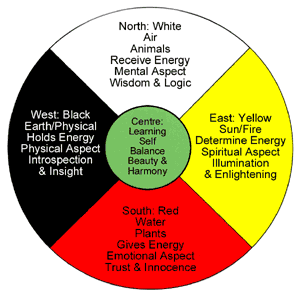Colour Groups
- Some societies see a meaning in the use of multiple colours with each contributing to the whole picture of life.
- Black, white, red, yellow, blue and green are the sacred colours of Buddhism.
- Hindus celebrate Holi as the festival of colours.
- The sacred colours of the Lakota tribe are red, white, yellow and black.
- To the Navajo, white, blue, yellow and black are the sacred colours.
WHITE
White symbolizes innocence and purity. Western brides often wear white or a variation of white such as ivory or blush.
To the Cherokees, white evokes peace and happiness.
The Roman Catholic Church uses white for joyful celebrations.
YELLOW
Yellow represents joy.
Yellow is used to represent life and God’s presence in Kente cloth of Africa.
Only the emperor of China, who was thought to link heaven and earth, was allowed to wear yellow. An exception was made for Buddhist monks who still wear saffron yellow, which is also sacred to Hindus.
GREEN
Green is the universal colour of life and hope.
Dark green represents life in Buddhism. Green Tara is youthful and vigorous.
Some Christian churches use green during the Trinity and Epiphany seasons. It is the colour of faith, the Trinity, and often the colour of the legendary Holy Grail.
Green is the colour of Irish Catholics. It is worn by Roman Catholic priests after Epiphany and Pentecost.
BLUE
Blue often stands for spirituality, grace and truth.
Buddhist rosaries are sometimes made entirely of turquoise, which represents long life and is a colour of the goddess Tara. Turquoise also has special meaning for Native Americans of the Southwest as it did for the Persians and ancient Egyptians.
The Blue Buddha is associated with healing.
Blue is the Cherokee colour for trouble.
In Chinese and in Jewish symbolism, blue has always represents heaven, possibly because our ancestors linked blue sky with heaven.
The usage of blue is becoming more popular in the Christian season of Advent.
Traditional representations of the Madonna often show her in blue, perhaps for chastity.
Lord Krishna of the Hindu faith is blue. Blue is also his colour as Vishnu.
Blue means holiness when it appears in African Kente cloth, which originated in Ghana.
Pagan sky gods like Amun of ancient Egypt, the Greek Zeus and the Roman Jupiter are often represented by blue.
| “Blue represented piety and sincerity in European heraldry: truth for the ancient Druids; mercy in the Kabbalah; and the Virgin Mary for Catholics. And in voodoo, blue is for protection and peace.” Susan Sargent, Susan Sargent’s The Comfort of Colour
|
RED
Red is the colour of blood and fire.
To the Cherokees, red is symbolic of victory.
The brides of India wear red to symbolize purity.
In Polynesia, red was associated with the ancient deities as well as the nobility.
In the Roman Catholic liturgy, red is worn in memory of Christ’s Passion and on the feast days of the Apostles and the martyrs.
The Red Cross and Red Crescent societies provide aid to those in need.
| “Mayan high priests wore red robes. The pope wears red slippers, and red signifies fire, sacrifice, and charity in the Catholic Church. In ancient Hebrew, the name of Adam – the first man, according to the Old Testament – means both “red” and “alive.” Susan Sargent, Susan Sargent’s The Comfort of Colour |
BLACK
The black goddesses of Hinduism, Durga and Kali, symbolize the duality of life and death.
http://www.greenlightwrite.com/sacredcolours.htm
A Medicine Wheel Schematic
In the Hopi Medicine Wheel of the Hopi prophecy of the four peoples of the Earth, the cardinal direction North represents the body, plants and animals, the colour white and ‘white skinned peoples’, and Childhood. (can also represent birth, and/or meeting a stranger and learning to trust as in infancy, explained in Erik Erikson’s stages of Psychosocial development). The East is held to represent the mind, air, the colour yellow and ‘yellow skinned peoples’, learning the groups to which people belong and Adolescence. The South holds the heart, fire, the colour red and ‘red skinned peoples‘, and Adulthood. Finally West holds the spirit, water, the colour blue or black, and ‘black-skinned peoples’ and Elderhood. West also represents the final life stage in the wheel, being an elder and passing on knowledge to the next generation so that the wheel may start again just like the circle it takes after. In many other tribes, however, the Northern direction corresponds to Adulthood (the White Buffalo), the South represents Childhood (the Serpent), the West represents Adolescence (the Bear) and the Eastern direction represents Death and Re-birth (Eagle). In terms of social dynamics, community building and the use of Circles in Restorative Justice work, the four quadrants of the circle correspond to Introductions, Trust Building, Problem Definition, and Generating Solutions.

Lakota Medicine Wheel
Source:
